|
The First Invasion of Quebec in the War of
1812
by Robert Henderson
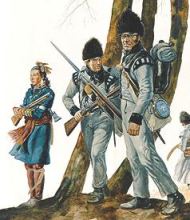
Canadian Voltiguers and
Kahnawake warriors advance to border (Parks Canada)
While
war raged in the autumn of 1812 along Upper Canada’s Niagara frontier,
American forces continued to slowly gather south of Montreal on
Lake Champlain. After dithering most of 1812, an American army
left Plattsburgh, NY on November 16 heading towards the border.
Before departing one officer of the 2nd US Infantry penned a
letter that captured the mood and expectations of the troops:
This is perhaps the last time you will hear from me at this
place, if ever. We are preparing for a march, which will take
place in a few days. It is intended to make an attack on Lower
Canada [Quebec] immediately. We march without baggage or tents,
and everything we carry will be on our backs, and the Heavens
and a blanket our only covering, till we take winter quarters by
force of arms. Our force is very respectable, say 6 or 7
thousand, and all in high spirits. The fatigues we expect to
undergo will be equal to those experienced by our revolutionary
heroes, till we arrive at Montreal.”[1]
Another officer estimated the army’s strength at around 5,000
men and thought the target was the island fort of Isle aux Noix
on the Richelieu River.[2]
Arriving to take command of the “Grand Army of Canada”[3]
was Major-General Henry Dearborn. Nicknamed “Granny” by those
he commanded, Dearborn appeared determined to strike deeply into
Canada. Writing to the Secretary of War, Dearborn opined that
Montreal could be taken “with but little risk” and envisioned a
winter campaign against Quebec City.[4]
It was not the first time Dearborn was in a winter attack on
capital of Lower Canada. Almost to the day 37 years earlier, in
1775, a younger Dearborn had been part of a daring American
overland move from New England against Quebec City. This
attack ended unsuccessfully with Dearborn suffering from small
pox as a prisoner of war in the city he dreamed of conquering.[5]
Now in 1812, Dearborn was a much older man and attacks of
rheumatism dampened the 61-year-old General’s ambition. The
result was his poor health delayed invasion plans for more than
a week.

Major-General Henry Dearborn (Courtesy of the Art Institute of
Chicago)
On November 18, with his army concentrated on the
frontier at Champlain NY, Dearborn dispatched reconnaissance
parties across the border to gather intelligence on the enemy.
In charge of the “videts” or seers was Colonel Isaac Clark.
Clark was also a American Revolution veteran who had gotten the
nickname of “Old Rifle” for “rifling” through (pillaging) French
Canadian churches during that war. After reconnoitring and
skirmishing with Canadian light troops, Clark
returned at the end of the day to report that about 300 native
warriors were lurking within a few miles of the border. He also
reported a large force of Canadian regulars and militia were
stationed about ten miles down the road to Montreal. Lastly
Dearborn was informed that the roads leading into Canada had
been obstructed in numerous places by fallen trees.[6]
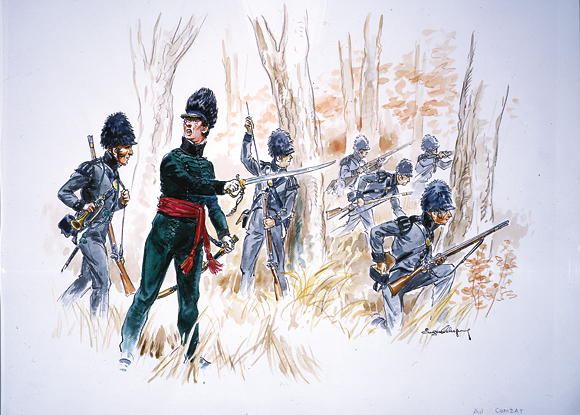
Natives, Canadian Voltigeurs, and
the Flank Companies of the 1st Battalion of Select Embodied
Militia skirmished with American advance parties south of
Lacolle River from November 18 to 22, 1812 (Parks Canada)
Preparing to meet the Americans was Major
Charles-Michel d'Irumberry De Salaberry of the newly-formed
Canadian Voltigeurs. Dressed in a green rifle-style uniform
trimmed with black mohair cording and dawning a unique bearskin
cap, De Salaberry was a professionally-trained light infantry
officer. He had served with the rifle battalion of the 60th
Regiment of Foot and the future father of Queen Victoria, the
Duke of Kent, had been his patron. De Salaberry had received
reports of the American advance the previous day and it was he
who had acted quickly to block the roads with abattis. The
Americans wildly overestimated the number of troops De Salaberry
had at his disposal. Instead of over two thousand, the French
Canadian Major had in fact only a few hundred men from his
regiment, the 1st Battalion of Select Embodied Militia, and some
Canadian Voyageurs stationed near the Lacolle River. In reserve eight
kilometres north of the Lacolle River were detachments of the
mentioned units along with the Canadian Fencible Regiment. While a
strict disciplinarian, De Salaberry could not be certain on how
the newly-formed Canadian Voltigeurs would fair in battle,
little alone the 1st Battalion of Select Embodied militia under his charge.

Charles-Michel d'Irumberry De Salaberry (Université de Montréal)
At least the Americans were right on the number of natives who
opposed them. Three hundred Mohawk warriors from Kahnawake,
south of Montreal, had answered the call to defend the
province. With the inclement November weather, the native
allies had set up camp on the north side of the Lacolle river.
About forty natives erected make-shift shelters to the left of
the bridge beside the Montreal road. Militiamen had also
constructed a crude log guardhouse among the native huts to
shelter the piquet patrolling that part of the river. With the
advance of the American army to the border, the bridge had been
wisely dismantled.
On the morning of November 19 Dearborn’s Adjutant
General issued orders that prepared his men for invasion: “the
General embraces the earliest opportunity to express his
confidence in the troops composing the army of the North. Their
bravery and patriotism will supply any deficiency in military
discipline and tactics which time and experience will render
perfect.”[7]
Not exactly a ringing endorsement of the army that was expected
to conquer Canada. Later that day, Dearborn’s invasion plan
received a setback. Militia officers informed the General that
no more than half of their men were willing to cross the
frontier into Canada.
Dearborn would later state to the Secretary of War
that, after meeting with his officers, it was decided that a
move on Montreal was no longer possible. According to Dearborn,
it was agreed that the army would remain a couple of days and
give the appearance of advancing, then return south to winter
quarters.[8]
However the General’s report to Washington appears dubious.
Dearborn had been slow and cautious throughout 1812 while he
built up what he considered to be an overwhelming force to take
Montreal. After Dearborn’s inaction and bragging about the ease
of taking Montreal, it is doubtful the General had abandoned his
quest for glory that day, contrary to what he later reported to
Washington.
While Dearborn’s enthusiasm for the campaign may
have been waning, one of his officers certainly was not. The
adventurous Colonel Zebulon Pike was chomping at the bit to
engage the enemy. Pike was well known at the time on both sides
of the border for his exploration of the West . This fame came
from his wildly popular published journals of his 1805-7
expeditions. Fighting the Shawnee in the Battle of Tippecanoe
in 1811 made Pike one of the few officers under Dearborn with
real experience countering native battle tactics.
Pike had spent months at Plattsburgh training his
regiment, the 15th US Infantry. Just before marching north, the
innovative Colonel embraced an experimental idea of equipping
part of his men with pikes:
Each subaltern is to carry a pike and a sword. The men are to
form three deep -- the tallest in the rear rank. The rear rank
have lately had their gun barrels cut off about 12 inches, and
not fitted for a bayonet. They are to be slung on the back,
when they proceed to a charge. The rear rank are to carry a
pike, somewhat of the form of a spontoon, attached to a pole 10
feet in length. Col. Pike thinks much of this kind of weapon,
while others condemn them.[9]
Scouting parties the previous day had reported an encampment at
the side of the road to Montreal on the north bank of the
Lacolle river. Pike persuaded Dearborn to allow him to attack
the enemy position there.
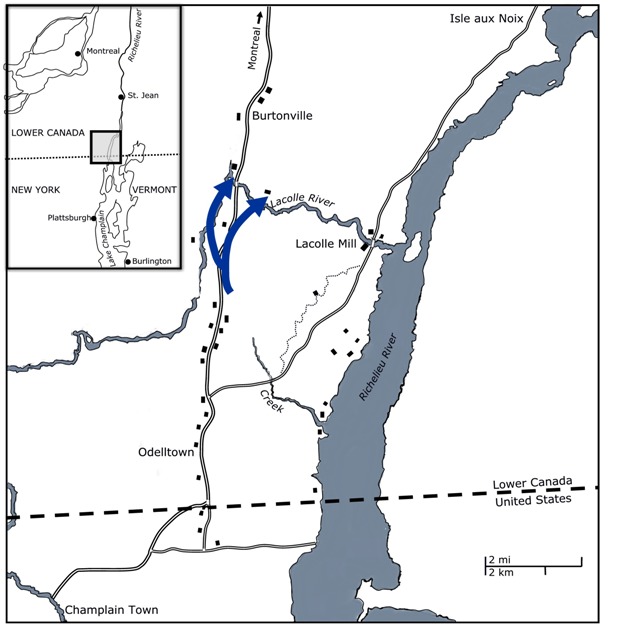
Map of the Lacolle Area and American
plan of attack. Left arrow represents Pike's Infantry
and the right arrow the 1st US Dragoons (Map: R Henderson)
On the night of November 19, Pike assembled his
regiment, and added volunteers from the militia under Major Melancton Smith and Major Guilford Young. Young of the Troy
Militia had already achieved the respect of his fellow officers
the previous month by capturing 40 Canadian Voyageurs at an
outpost near St. Regis. A troop of 1st Light Dragoons was also
added, bringing the strike force to between 600 and 850
effectives.[10]
While Pike was to attack the encampment, the Dragoons under the
guidance of Colonel Clark were to move against any enemy
stationed at a saw mill just east of the road. Pike’s plan was
to divide his infantry into two and encircle the guardhouse and
huts. He would lead most of the 15th US Infantry and Smith and
Young would direct the militia, which had been augmented by some
of his regulars.

Zebulon Pike (National Parks Service)
Pike’s preparations did not go unnoticed by the
prying eyes of British spies. While American militia volunteers
were being recruited, word of the planned attack reached the
ears of Prevost. The Governor General responded by dispatching
a hasty note the same day to De Salaberry warning him of a
possible attack:
If information can be relied on, the enemy will advance this day
from ChamplainTown. I have given directions for your support
from several points. You must keep them entangled in the woods
as long as possible. I rely on your best exertions.[11]
The message did not arrive in time. Still De Salaberry was
prepared: “The troops I had with me, have been laying in the
woods in the open air for ten days, always fully accoutred and
in momentary expectation of the enemy.”[12]
Constantly exposed to the November rain and cold the healthy
constitutions of the Canadians defending the border were slowly
chipped away at. One tired young French Canadian officer
of the 1st Battalion of Select Embodied Militia later wrote:
"After
five weeks to today (Nov 30) of continued hardships in the woods
of Canada ... I hope now to pass the winter quietly; for though
to serve one's country to the utmost of one's power and force,
be every one's duty, yet to serve it as I have done for five
weeks is very hard."
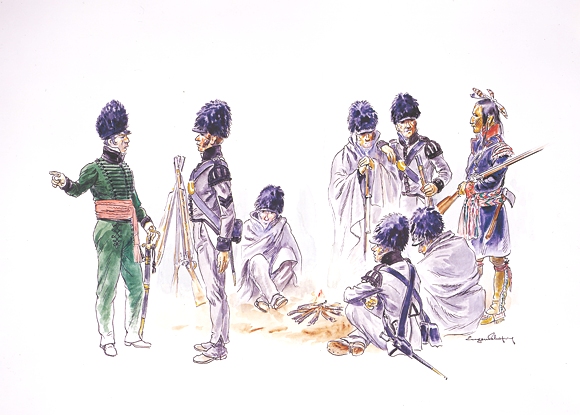
Canadian Voltigeurs on piquet duty
(Parks Canada)
Under the cover of darkness, Pike’s men quietly
exited their crude shelters of spruce boughs and moved out of
their Army’s encampment. As they crossed the border near Odelltown, it began to snow. For hours they trudged through the
snowy night, reconnoitring the swamps to the east of the road
for enemy pickets. After a brief rest for “regaling themselves
with potato whiskey and a good cheer from their commander” they
continued on through the darkness and cold. By then the snow
storm had subsided. The moon now helped light the rest of their
journey.[13]
At about 4 o’clock in the morning, Young’s Troy
Fusiliers and Smith’s militia volunteers were first to reach at
the banks of the narrow Lacolle River to the west of the road.
A native lookout was spotted and they moved to surprise him.
One witness recounted:
the Troy Fusiliers...crossed the river first, and proceeded down
the river, sometimes in the water and sometimes upon the bank,
about the distance of 40 or 50 rods, while a detachment of the
Pennsylvania regulars crossed and proceeded up the west side of
the point of land formed by a bend in the river, until they came
opposite to the Troy Fusiliers. All this manoeuvre was
performed wih the utmost silence, while every man had his eye
upon a poor Indian, the object of their pursuit.[14]
While in the process of relieving Native sentries stationed at
an oak tree that stretched across the river, 40-year-old Captain
William McKay of the Canadian Voyageurs “heard the enemy all
round him cocking their musquets.”[15]
McKay yelled loudly to warn the Native lookout of the impending
danger. The Americans responded with a “devil of a discharge”
of musket fire at McKay and his warriors.[16]
The Mohawk sentries jumped behind logs and trees, and, with
yells, returned fire. Hopelessly outnumbered, McKay retreated.

Mohawk warrior in Autumn by
Ron Volstad (Dept. of National Defence)
Meanwhile at the road, Pike’s men filed quickly into
the frozen waters of the shallow Lacolle river. By the time the
Americans climbed the rocky river bank, the Canadian militiamen
and native warriors housed at the guardhouse and shacks had
stealthily pulled out. So quick was the silent evacuation that
militia Captain Bernard Panet didn’t have a chance to lace his
shoes. The American troops under Smith and Young quickly swung
to the northern perimeter of the now deserted encampment, while
Pike’s force moved to close the trap by pushing from the south.
With visibility hampered by the darkness of the surrounding
woods of the early morning hour, the situation was ripe for
mistakes. The dangerousness of the moment was eloquently
summarized by Captain Jacques Viger of the Canadian Voltigeurs
who wrote: “In the night, all cats are grey.”[17]
The New York militia with Smith and Young entered
the small, lifeless shanty village searching for the enemy.
Large fires were burning but no one warmed themselves by them.
The Americans immediately entered the huts with fixed bayonets
expecting to catch a slumbering enemy unaware. Meanwhile Pike’s
men came up to the huts and guardhouse from the south right when
the New York militiamen were exiting the huts. Mistaking them
as the enemy, Pike’s force open fired. In response, Smith and
Young’s men discharged their arms and a devastating exchange of
friendly-fire ensued.[18]
The Natives urged on the folly with “horribly frightful yelling”
from the surrounding woods. So loud were the hoots and hollers
of the Kahnawake warriors that the Americans “imagined that
there were 4 or 500 Indians around them.”[19]
The fire-fight could be heard all the way back at
the American encampment in Champlain, New York. One officer of
the 16th US Infantry remembered:
When the firing of Colonel Pike’s party was heard, General
Chandler galloped into camp, exclaiming in a loud voice, “Where
is Colonel Pearse?” At that time, Colonel Pearce was lying under
a spruce brush, wrapped in a rug. He immediately arose, shook
the snow off, and ordered the troops to be paraded. As soon as
the cause of the firing was known, they were dismissed.[20]
After
five or six volleys Pike’s men realized their error and ceased.
The crude log guardhouse was torched and the Americans pulled
back empty-handed across the river.
With the native yells ringing in their ears, the
American withdrawal was rapid and disorderly. Meanwhile the US
Dragoons further east along the river torched some buildings and
then withdrew using a sawmill dam as a bridge to cross the
river. In the confusion, some of Pike’s men were taken as
prisoners. To speed their retreat, some soldiers threw away
their muskets and pikes. After carrying their wounded part of
the way through the snow, sleighs were commandeered to finish
the journey back across border. Later the Montreal Herald
mocked Pike’s misfortune by sarcastically naming the engagement
the “suicidal battle of River Lacolle”.[21]
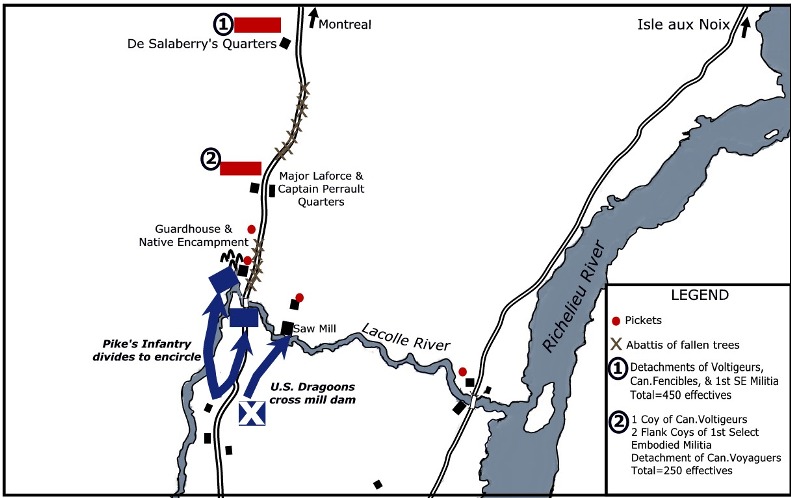
Map of Troop Positions and Movement,
November 20, 1812 (Map: R Henderson)
Captain McKay of the Canadian Voyageurs must have
taken particular pleasure at the news that Major Young was part
of the defeated American force. Young’s capture of Voyageurs at
St Regis a month earlier would have felt to a degree avenged.
In the daylight Lower Canadian troops were able to study
American armaments for the first time in the war:
The American muskets (we found many on the battlefield) are
strongly built and their barrel is fastened to the stock with
three large hoops of iron. Their bayonets, built like our, are
shorter and stronger. Their cartridge [musket round] contain
one bullet and three posts. We also found spears, the wood of
which is very long with a curved and sharpened spearhead.
[translation][22]
This was an accurate description of the US Springfield musket,
buck-and-ball musket rounds, and the 10 foot pikes of the 15th
US Infantry. The ferocity of the American volleys was also
evident. One militia officer noted “all the neighbouring trees
around being covered with bullets (one of our officers says that
he counted 20 balls in a space of about half a foot square).”[23]
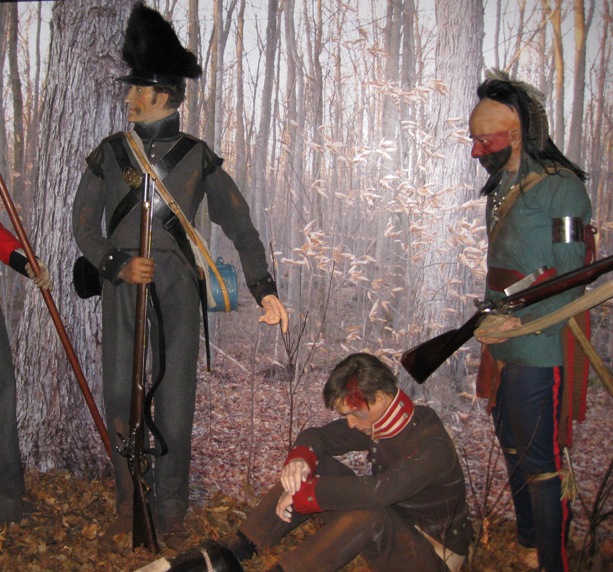
American prisoner with Canadian Voltigeur and Mohawk warrior.
Display by
Militaryheritage.com
(photo: R Henderson)
Also during the following day, De Salaberry and
Major Pierre Laforce assessed the intent of Pike’s night-time
incursion into Canada. Evidence of it being a precursor to a
larger American offensive started to mount. Spies brought news
from the American camp that the army cooks had started to
prepare three days’ worth of soldier’s rations for the march.
Concluding this was a prelude to invasion, Laforce was ordered
to evacuate the local population. Knowing Dearborn’s army were
without camp equipage and intended to live off the land as they
advanced, Laforce was directed to herd local livestock north,
destroy any food supplies that could feed the invaders, and burn
any civilian buildings that could shelter Dearborn’s troops.[24]
On De Salaberry’s strategy, Prevost wrote “I approve the
precautionary measure you propose taking on the enemy’s
advance. Keep the cattle in your rear and make sure of whatever
you require for the troops, giving receipts on the Commissary
General, also for the hay you may destroy.”[25]
In effect, the Canadians had deployed the attrition strategy of
scorched earth.
With an early snow on the ground and plumbs of smoke
rising in the distance from Laforce’s grim work, Dearborn’s plan
for a late-season invasion was in tatters. Dysentery,
diarrhoea, measles and the first cases of typhus plagued the
General’s army and the plummeting temperatures were only making
the situation worse.[26]
Pike’s infectious zeal had not produced victory. Adding to his
painful attacks of rheumatism, “Granny” Dearborn had caught a
case of cold feet. The refusal of part of the militia to cross
the border offered Dearborn the excuse needed to abandon the
invasion. However the American troops under his command were
shocked at the decision. One officer recounted:
On the 22nd, at an early hour, we were ordered to cook three
days’ provisions. This order produced great joy - each regiment
supposing, of course, that Montreal was our destination. At. 10
o’clock AM when all was ready, our route was announced for
Plattsburgh, which occasioned much murmuring among the troops.[27]
However one American journalist took strange consolation in the
nature of Dearborn’s retreat:
That this expedition has ended with less bloodshed and disaster
than those of Detroit and Queenstown! And that his advance and
retrograde movements have not less merit than those recorded on
one of our allies, in this couplet of the poet:
‘A King of France with 20,000 men,
Marched up a hill, and then marched down again.’[28]

American Soldiers on the march. (pub. 1813)
So
ended the first invasion of Lower Canada. While militarily less
significant, Dearborn’s failure was greatly encouraging to the
population of Lower Canada. Dearborn had trumpeted the belief
of a disaffected French Canada unwilling to support Britain over
the United States. He had been proven wrong. The border had
been successfully defended by untested French Canadian troops
without any British assistance at all. For the next two
years Canadian units would be the primary protectors of the
province's border and contend with two more invading American
armies.
Today
The sleepy town of Lacolle now rests on the location
of the engagement that occurred in the early morning hours of
November 20, 1812. The town hall sits on the road to Montreal,
a stone’s throw from the bridge spanning the small Lacolle
River. The road to the U.S. border has not
changed much in 200 years and you can still cross into New York
State there. A history
interpretative centre has now been built in Lacolle to
commemorative the battle there, along with telling the rest of
the community’s story. The Battle on the Lacolle River in 1812
is often confused with the Battle of Lacolle Mill in 1814. Each
involved a mill, a wooden military structure, and a bridge
crossing the Lacolle River. However the battle in 1814 occurred
principally around a stone grist mill and log blockhouse on the
road running beside the Richelieu River. While the events
on the Lacolle River in 1812 were motivating to the Canadian war
effort, the spot has not yet been recognized as a National Historic
Site. This is likely do to the confusion with the battle
in 1814. It is hoped this research has removed this hurtle to
achieving this recognition.
As for the Canadian defenders involved in protecting
the province of Quebec that November, the history and heritage
of those regiments are now preserved by units of the Canadian
Forces through perpetuation:
|
1812 Unit |
Canadian Forces Unit |
|
Canadian
Regiment of Fencible Infantry |
Royal 22e
Régiment |
|
Provincial
Corps of Light Infantry (Canadian Voltigeurs) |
Les
Voltigeurs de Québec |
|
1st
Select Embodied Militia of Lower Canada |
Le Régiment
de la Chaudière |
|
Canadian
Voyageurs |
The Canadian
Grenadier Guards |
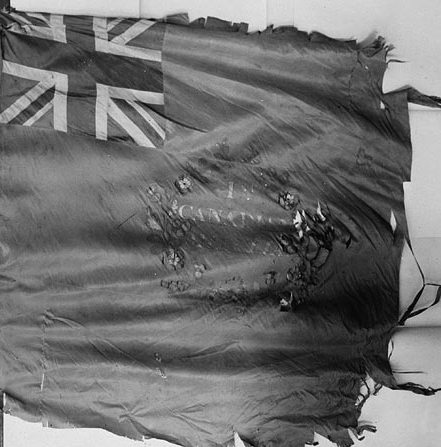
Regimental Colour of the 1st
Battalion of Select Embodied Militia. "1st Canadian Militia"
is painted on the colour. (Library and Archives Canada)
The
defence of Lacolle River is recognized as part of the "DEFENCE
OF CANADA 1812-1815" Campaign Honour, awarded to the units
of the Canadian
Forces listed above.
The
service of Kahnawake First Nation was also remembered recently
with the awarding of commemorative silver Chief’s medals by the
Governor General of Canada. Two hundred years ago, Chief’s
medals also conveyed friendship and gratitude from the
Government to the native peoples.
De Salaberry’s leadership at
Lacolle was commemorated in 1881 with
the erection in Chambly (Quebec) of a bronze statue to him, and
bearing the name “LACOLLE” on one side. Canadian Army
units played a prominent role in the project and the unveiling
ceremony. The memorial can be seen on the Canadian Forces
website by
clicking here. Also a small video on the monument
(en français)
can be found here. Along with his house being made a
National Historic Site and statues of him in both Quebec City
and Ottawa, De Salaberry was designated a person of national
significance in 1934. In addition communities have
been named after him including Salaberry and Salaberry-de-Valleyfield
in Quebec and De Salaberry in Manitoba, Also Salaberry Armoury
in Gatineau (Quebec) was named after him in 1938 for his
military service in the war, along with numerous streets in
Quebec and Ontario. His Voltiguers were also honoured by
the naming of streets in a number of communities, along with a
park in Drummondville (Quebec).
Je me souviens.
Acknowledgements
I would like to thank Gilles Pellerin, the
President de la Société
d'histoire Lacolle-Beaujeu
for his kind assistance and support in writing this
article. Mr Pellerin was the driving force behind
establishing an 1812 Interpretative Centre in Lacolle.
You can visit
the site here. Also my thanks
goes to André Gousse
for pointing out other ways De Salaberry and his Voltigeurs
canadiens have been commemorated.
[26]
James
Mann, Medical Sketches of the Campaigns of 1812,13,14.
(Dedham, 1816) p. 19.
|

